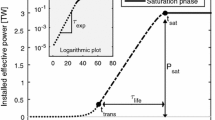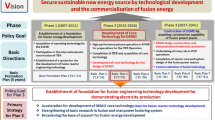Abstract
We examine potential early markets for fusion energy and their projected cost targets, based on analysis and synthesis of many relevant, recent studies and reports. Seeking to provide guidance to ambitious fusion developers aspiring to enable commercial deployment before 2040, we examine cost requirements for fusion-generated electricity, process heat, and hydrogen production based on today’s market prices but with various adjustments relating to possible scenarios in 2035, such as “business-as-usual,” high renewables penetration, and carbon pricing up to 100 $/\(\hbox {tCO}_2\). Key findings are that fusion developers should consider focusing initially on high-priced global electricity markets and consider including integrated thermal storage, depending on techno-economic factors, in order to maximize revenue and compete in markets with high renewables penetration. Process heat and hydrogen production will be tough early markets for fusion, but may open up to fusion as markets evolve and if fusion’s levelized cost of electricity falls below 50 $/\(\hbox {MWh}_{\mathrm {e}}\). Finally, we discuss potential ways for a fusion plant to increase revenue via cogeneration (e.g., desalination, direct air capture, or district heating) and to lower capital costs (e.g., by minimizing construction times and interest or by retrofitting coal plants).






Similar content being viewed by others
References
National Academies of Sciences, Engineering, and Medicine, Bringing Fusion to the U.S. Grid (NAP, Washington, DC, 2021), https://doi.org/10.17226/25991
National Academies of Sciences, Engineering, and Medicine, Negative Emissions Technologies and Reliable Sequestration: A Research Agenda (NAP, Washington, 2019), https://doi.org/10.17226/25259
C.L. Nehl, R. Umstattd, W.R. Regan, S.C. Hsu, P.B. McGrath, J. Fusion Energy 38, 506 (2019). https://doi.org/10.1007/s10894-019-00226-4
ARPA-E ALPHA program, https://arpa-e.energy.gov/technologies/programs/alpha
ARPA-E BETHE program, https://arpa-e.energy.gov/technologies/programs/bethe
ARPA-E GAMOW program, https://arpa-e.energy.gov/technologies/programs/gamow
T.L. Peckinpaugh, R.P. Stimers, M.L. O’Neill (2018). Invigorated Federal Interest in Fusion Energy Presents Opportunities and Questions for Growing Private Fusion Energy Sector, https://www.klgates.com/Invigorated-Federal-Interest-in-Fusion-Energy-Presents-Opportunities-and-Questions-for-Growing-Private-Fusion-Energy-Sector-10-12-2018
A.C. Roma, S.S. Desai (2020). The Regulation of Fusion–A Practical and Innovation-Friendly Approach, https://www.hoganlovells.com/~/media/hogan-lovells/pdf/2020-pdfs/2020_02_14_hogan_lovells_the_regulation_of_fusion_a-practical.pdf
Fusion Industry Association (2020). Igniting the Fusion Revolution in America, https://www.fusionindustryassociation.org/post/fusion-regulatory-white-paper
D.R. Lewis, J.S. Merrifield, S.L. Fowler (2020). Considerations for Regulation of Fusion-Based Power Generation Devices, https://www.pillsburylaw.com/images/content/1/4/v4/144195/Article-Licensing-Fusion-Power-Nov2020.pdf
DOE, NRC, and FIA Public Forum (2020). Virtual Public Forum on a Regulatory Framework for Fusion, https://science.osti.gov/fes/Community-Resources/Workshop-Reports/DOE-NRC-FIA-Public-Forum
World Bank Group, State and Trends of Carbon Pricing 2019 (World Bank, Washington, DC, 2019). http://hdl.handle.net/10986/31755
E. Ingersoll, K. Gogan, J. Herter, A. Foss (2020). Cost and Performance Requirements for Flexible Advanced Nuclear Plants in Future U.S. Power Markets, https://www.lucidcatalyst.com/arpa-e-report-nuclear-costs
S. Woodruff, E. Ingersoll, A. Foss, R.L. Miller (2020). Revisit of the 2017 Costing for Four ARPA-E ALPHA Concepts, https://arpa-e.energy.gov/technologies/publications/updated-cost-study-and-final-report-four-alpha-fusion-concepts
C. Turchi, G. Heath (2013). Molten Salt Power Tower Cost Model for the System Advisor Model, https://www.nrel.gov/docs/fy13osti/57625.pdf
E. Bubelis, W. Hering, S. Perez-Martin, Fus. Eng. Des. 146, 2334 (2019). https://doi.org/10.1016/j.fusengdes.2019.03.183
Lazard (2019). Lazard’s Levelized Cost of Energy Analysis–Version 13.0, https://www.lazard.com/media/451086/lazards-levelized-cost-of-energy-version-130-vf.pdf
U.S. Energy Information Administration (2020). Levelized Cost and Levelized Avoided Cost of New Generation Resources in the Annual Energy Outlook 2020, https://www.eia.gov/outlooks/aeo/pdf/electricity_generation.pdf
J. Platt, J.O. Pritchard, D. Bryant (2017). Analyzing energy technologies and policies using DOSCOE, https://dx.doi.org/10.2139/ssrn.3015424
BP (2020). Statistical Review of World Energy, https://www.bp.com/content/dam/bp/business-sites/en/global/corporate/pdfs/energy-economics/statistical-review/bp-stats-review-2020-natural-gas.pdf
H. Ritchie, M. Roser (2017). Fossil Fuels, https://ourworldindata.org/fossil-fuels
N.A. Sepulveda, J.D. Jenkins, F.J. de Sisternes, R.K. Lester, Joule 2, 2403 (2018). https://doi.org/10.1016/j.joule.2018.08.006
M. Ford, A. Abdullah, Risk Anal. (2021). https://doi.org/10.1111/risa.13727
MIT Energy Initiative (2018). The Future of Nuclear Energy in a Carbon-Constrained World, https://energy.mit.edu/wp-content/uploads/2018/09/The-Future-of-Nuclear-Energy-in-a-Carbon-Constrained-World.pdf
BloombergNEF (2019). Hydrogen: The Economics of Industrial Heat in Cement, Aluminum and Glass, https://about.bnef.com/product
IEA (2019). The Future of Hydrogen, https://www.iea.org/reports/the-future-of-hydrogen
BloombergNEF (2020). Hydrogen: The Economics of Production from Fossil Fuels With CCS, https://about.bnef.com/product
BloombergNEF (2019). Hydrogen: The Economics of Production from Renewables, https://about.bnef.com/product
S.P.S. Badwal, S. Giddey, C. Munnings, Energy Environ. 2, 473 (2012). https://doi.org/10.1002/wene.50
M. Serban, M.A. Lewis, C.L. Marshall, R.D. Doctor, Energy Fuels 17, 705 (2003). https://doi.org/10.1021/ef020271q
Hydrogen Production: Thermochemical Water Splitting, https://www.energy.gov/eere/fuelcells/hydrogen-production-thermochemical-water-splitting
M.L. Carreon, Plasma Res. Express 1, 043001 (2019). https://doi.org/10.1088/2516-1067/ab5a30
BloombergNEF (2019). Hydrogen: Making Green Ammonia and Fertilizers, https://about.bnef.com/product
BloombergNEF (2019). Hydrogen: The Economics of Low-Carbon Methanol, https://about.bnef.com/product
BloombergNEF (2019). Hydrogen: Making Fossil-Free Steel, https://about.bnef.com/product
A. Boretti, L. Rosa, npj Clean Water 2, 15 (2019). https://doi.org/10.1038/s41545-019-0039-9
J. Robbins (2019). As Water Scarcity Increases, Desalination Plants Are on the Rise, https://e360.yale.edu/features/as-water-scarcity-increases-desalination-plants-are-on-the-rise
World Bank Group, The Role of Desalination in an Increasingly Water-Scarce World (World Bank, Washington, DC, 2019). http://hdl.handle.net/10986/31416
IRENA (2012). Water Desalination Using Renewable Energy, https://irena.org/-/media/Files/IRENA/Agency/Publication/2012/IRENA-ETSAP-Tech-Brief-I12-Water-Desalination.pdf
S. Qvist (2020). Nuclear Power Plants as Integrated Energy Centres, unpublished
IPCC (2018). Global Warming of \(1.5^\circ \), https://report.ipcc.ch/sr15/pdf/sr15_spm_final.pdf
R. Hanna, A. Abdulla, Y. Xu, D.G. Victor, Nature Comm. 12, 368 (2021). https://doi.org/10.1038/s41467-020-20437-0
G. Peters, O. Geden, Nature. Clim. Change 7, 619 (2017). https://doi.org/10.1038/nclimate3369
M. Fasihi, O. Efimova, C. Breyer, J. Clean. Prod. 224, 957 (2019). https://doi.org/10.1016/j.jclepro.2019.03.086
IAEA (2017). Opportunities for Cogeneration with Nuclear Energy, Report No. NP-T-4.1, https://www-pub.iaea.org/MTCD/Publications/PDF/P1749_web.pdf
Clean Air Task Force (2018). Advanced Nuclear Energy, https://www.catf.us/wp-content/uploads/2018/04/Advanced_Nuclear_Energy.pdf
S. Qvist, P. Gladysz, L. Bartela, A. Sowizdzal, Energies 14, 120 (2021). https://doi.org/10.3390/en14010120
World Resources Institute (2019). Global Power Plant Database, https://datasets.wri.org/dataset/globalpowerplantdatabase
S. Woodruff, R. Miller, D. Chan, S. Routh, S. Basu, S. Rao (2017). Conceptual Cost Study for a Fusion Power Plant Based on Four Technologies from the DOE ARPA-E ALPHA Program, https://doi.org/10.13140/RG.2.2.24116.55688
J. Cassibry, R. Cortez, M. Stanic, A. Watts, W. Seidler, R. Adams, G. Statham, L. Fabisinski, J. Spacecraft Rockets 52, 595 (2015). https://doi.org/10.2514/1.A32782
G.A. Wurden, T.E. Weber, P.J. Turchi, P.B. Parks, T.E. Evans, S.A. Cohen, J.T. Cassibry, E.M. Campbell, J. Fusion Energy 35, 123 (2016). https://doi.org/10.1007/s10894-015-0034-1
Acknowledgements
We are grateful for the insights and input provided by many people, especially Bob Mumgaard, Brandon Sorbom, Shiaoching Tse, and Ally Yost (Commonwealth Fusion Systems), Joe Chaisson (Clean Air Task Force, Energy Options Network), Eric Ingersoll (Lucid Catalyst), Armond Cohen (Clean Air Task Force), and Richard Pearson (Kyoto Fusioneering). We thank Jennifer Steinhilber (Booz Allen Hamilton) for assistance with several of the figures. Reference herein to any specific non-federal person or commercial entity, product, process, or service by trade name, trademark, manufacturer, or otherwise, does not necessarily constitute or imply its endorsement, recommendation, or favoring by the U.S. Government or any agency thereof or its contractors or subcontractors.
Author information
Authors and Affiliations
Corresponding author
Additional information
Publisher's Note
Springer Nature remains neutral with regard to jurisdictional claims in published maps and institutional affiliations.
The authors’ affiliation does not imply endorsement of this work by ARPA-E, DOE, or the U.S. Government.
Supplementary Information
Below is the link to the electronic supplementary material.
Rights and permissions
About this article
Cite this article
Handley, M.C., Slesinski, D. & Hsu, S.C. Potential Early Markets for Fusion Energy. J Fusion Energ 40, 18 (2021). https://doi.org/10.1007/s10894-021-00306-4
Accepted:
Published:
DOI: https://doi.org/10.1007/s10894-021-00306-4




